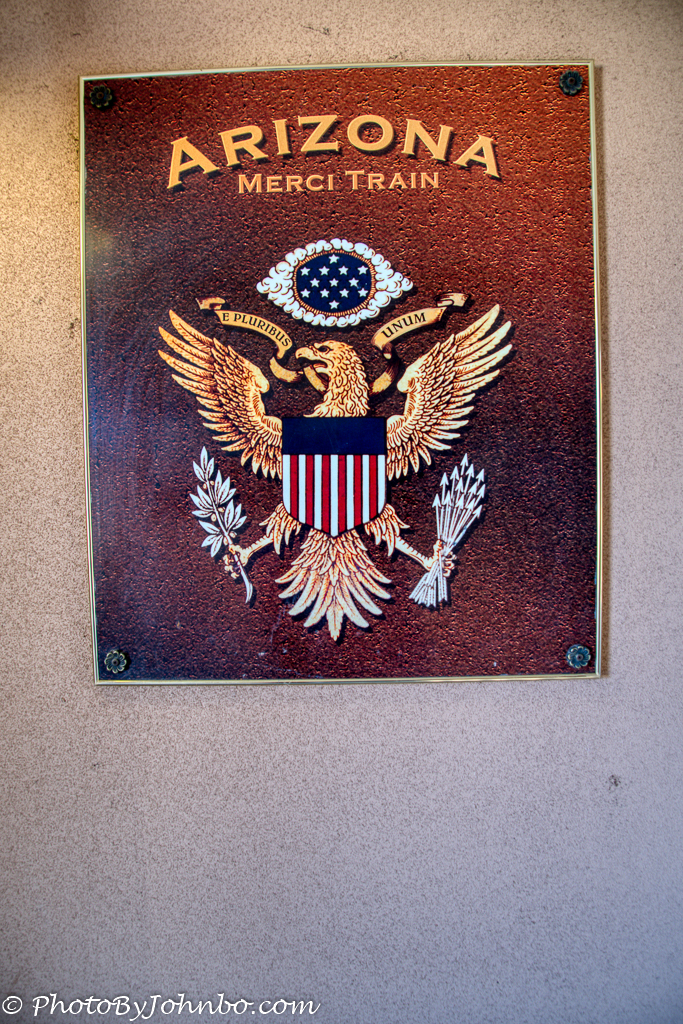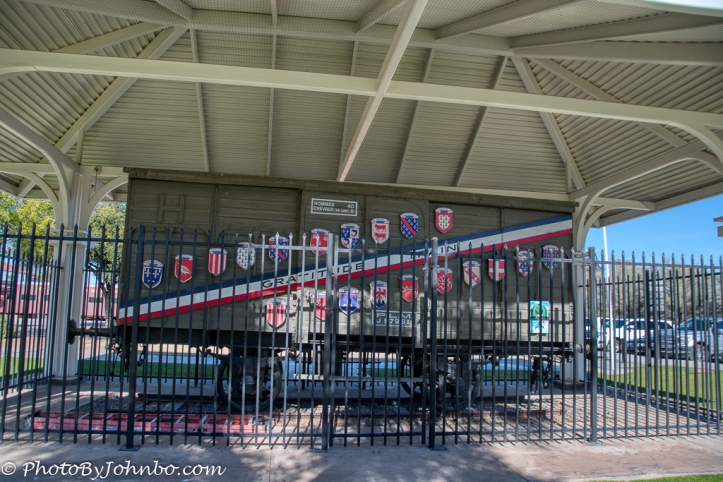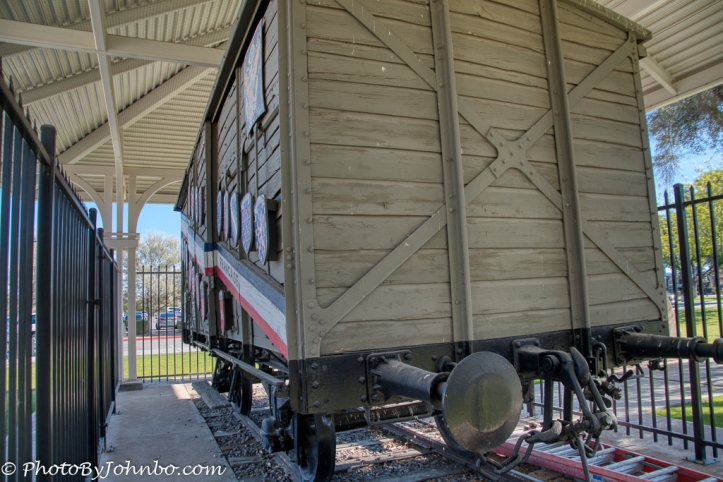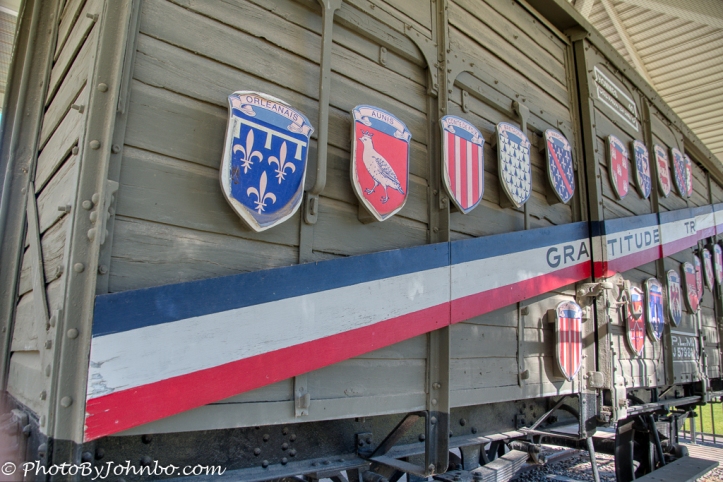After World War II, it was no secret that Europe had a long road to recovery and in 1947, more than 700 American box cars containing about $40 million dollars in relief goods provided by principally individual Americans were delivered to France and Italy to help the formerly occupied nations recover. Two years later, in February 1949, forty-nine French railroad box cars filled with thousands of gifts of gratitude were shipped to the United States. There was one boxcar for each of the 48 states and a boxcar to be shared by Washington D.C. and the territory of Hawaii. The rail cars were French box cars, military transport freight cars dubbed Forty-and-Eights because they were rated to carry 40 troops or 8 horses.
Accompanied by a delegation of French officials, the train traveled throughout the United States with ceremonies of gratitude from the French people at most delivery points. The photos of the train cars show them riding on American flat cars because the wheel spacing (gauge) of track width in France is different from U.S. gauge. A link to a site dedicated to the Merci Train provides much more in-depth detail on the train and location of cars and artifacts here.
 Arizona’s train car is on display at the McCormick-Stillman Railroad Park, a location I’ve written about twice before. The museum in the park holds a sample of gifts provided in the Arizona car, but a larger rotating display of artifacts can be viewed at the Arizona Capitol Museum in Phoenix. The plaque in the image above is posted near the train car on display in the Scottsdale railroad park.
Arizona’s train car is on display at the McCormick-Stillman Railroad Park, a location I’ve written about twice before. The museum in the park holds a sample of gifts provided in the Arizona car, but a larger rotating display of artifacts can be viewed at the Arizona Capitol Museum in Phoenix. The plaque in the image above is posted near the train car on display in the Scottsdale railroad park.
 In the park, under a covered pavilion, protected by a large fence, you will see the Arizona train car. With the fence surrounding the car at a very close range, it is hard to get a good photograph of the shields, each representing a French province, displayed on the car’s exterior. The concept of a gratitude train was initiated by Andre, Picard, a French rail worker, and war veteran. Each of the shields on the cars represented the 40 provinces of France.
In the park, under a covered pavilion, protected by a large fence, you will see the Arizona train car. With the fence surrounding the car at a very close range, it is hard to get a good photograph of the shields, each representing a French province, displayed on the car’s exterior. The concept of a gratitude train was initiated by Andre, Picard, a French rail worker, and war veteran. Each of the shields on the cars represented the 40 provinces of France.
 Prior to attending this park, I had not heard of the Merci Train. I got schooled in the park’s railroad museum, but it wasn’t until I started researching for this post that I was to discover that North Dakota’s 40 and 8 train car is on display in Bismarck. Artifacts are on display in the State Historical Society’s museum, but you, dear reader, don’t have to go there to see what kinds of gifts were presented to the people of North Dakota. An online interactive exhibit here will provide you with a link to view some of the objects on display as well as provide background on each of the 40 shields affixed to each 40 and 8. According to the North Dakota Historical Society website, only 43 of the original 49 cars are still in existence and North Dakota is one of the few states that still has most of the train’s contents.
Prior to attending this park, I had not heard of the Merci Train. I got schooled in the park’s railroad museum, but it wasn’t until I started researching for this post that I was to discover that North Dakota’s 40 and 8 train car is on display in Bismarck. Artifacts are on display in the State Historical Society’s museum, but you, dear reader, don’t have to go there to see what kinds of gifts were presented to the people of North Dakota. An online interactive exhibit here will provide you with a link to view some of the objects on display as well as provide background on each of the 40 shields affixed to each 40 and 8. According to the North Dakota Historical Society website, only 43 of the original 49 cars are still in existence and North Dakota is one of the few states that still has most of the train’s contents.
It looks like a visit to the North Dakota Historical Society’s museum is in order for when we can travel more freely again, followed by an epilog to this story focusing on the North Dakota 40 and 8. France wasn’t the only country to express their gratitude for aid. Italy provided a motion picture film of the American aid being distributed to be shown in theaters across the United States, and in gratitude for helping rid the country of Mussolini and the Nazis, they provided four bronze sculptures that are now on bridge abutments in Washington DC. The people of the Netherlands also sent a gift of a large carillon now located near the National U.S. Marine memorial in Arlington.
Notice: This post is being written during the COVID-19 pandemic and at this time, both the McCormick-Stillman Railroad Park is open to visitors but there are limitations. Be sure to check online for the status of the venue before traveling. Please stay safe and follow your state or country’s guidelines for travel in your region.
John Steiner


I’d never heard this story before either. Thank you for sharing it.
Always interesting to discover something not known before. This story of gratitude was a complete surprise to me.
Yes, many thanks for showing the train car and for sharing the story. Every day that one can learn something new is usually a good day.
Indeed!
Of course, I should have written “Any day that” and not “Every day that.”
Wow, a touching expression of international gratitude. Sadly it seems like this is something that no longer exists.
Isn’t that the truth. Thanks for stopping by and commenting.
🙂
What a beautiful gesture, from both sides of the Atlantic!
Indeed! I was surprised to learn this.
Thanks for the history lesson as I had never heard of this! How Euro, leave it to France to give the gift of public transportation. Hahaha 😉
News to me as well. It is refreshing to hear there was a significant token of gratitude for the donations of food and supplies. I was also unaware of the gift of thanks from Italy.